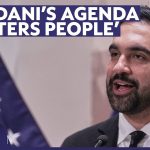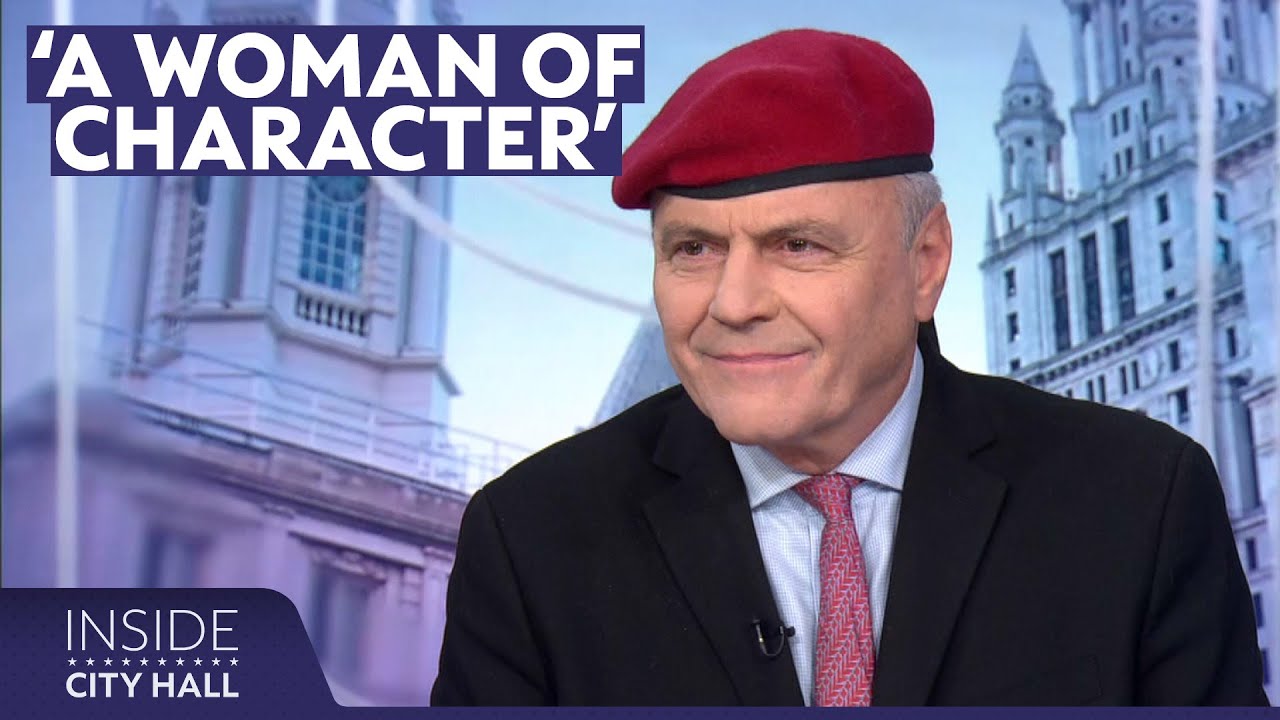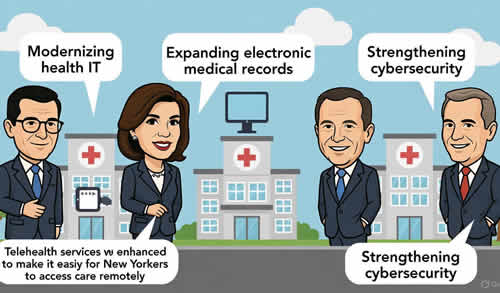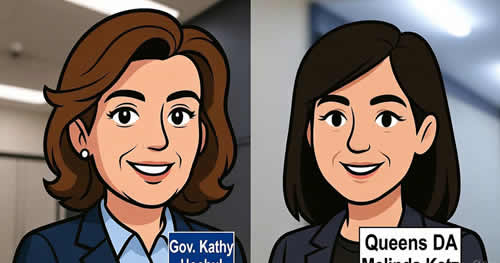In a recent appearance on NY1’s Mornings on 1, Governor Kathy Hochul reinforced her proposal to ban smartphone use in schools during class hours, citing concerns over student distractions, mental health, and declining social skills. Backed by Tech:NYC, a major technology advocacy group, Hochul emphasized the need to create a focused learning environment and reduce social media’s negative impact on youth. She also addressed key state issues, including public safety, affordability measures, and congestion pricing, underscoring her commitment to policies that enhance education, economic relief, and quality of life for New Yorkers.
Febriary 6, 2025 Governor Kathy Hochul was a guest on NY1’s “Mornings on 1” with Pat Kiernan alongside Tech:NYC President and CEO Julie Samuels to discuss the Governor’s proposal to restrict the use of smartphones in schools bell-to-bell, allowing students to learn and communicate in a distraction-free environment.
Governor Kathy Hochul · Governor Hochul
is a Guest on NY1’s “Mornings on 1” With Pat Kiernan
A rush transcript of the Governor’s remarks is available below:
Pat Kiernan, NY1: This morning, an in depth conversation with Governor Kathy Hochul. She was in the studio with me yesterday. We talked about a lot of different topics, including how she’s pushing for the needs of the City and the State with Donald Trump back in the White House, and we talked about the Governor’s proposal to take phones out of the hands of students during the school day.
Governor Hochul: We’re not developing the skills we need because kids are distracted with the cell phones. And also — how hard it is for our teachers, trying to teach algebra and geography and they’re competing with viral dances and messages from their friends, and sometimes threats and bullying. How do you pay attention to the subject at hand when this is going on? It didn’t happen when we were younger.
Pat Kiernan, NY1: That was the Governor’s speech a few weeks ago. Today, the Governor’s smartphone ban, getting an endorsement from one of the City’s biggest technology nonprofits, Tech:NYC, which represents some of the social media companies, AI companies and tech companies. The Governor was joined for our interview by the Tech:NYC President and CEO, Julie Samuels. I started by asking what the Governor’s been hearing from parents and teachers and students when it comes to the distraction that phones cause.
Governor Hochul: I went on a journey about a year ago to go around the State convening roundtables with students and parents and administrators, principals too, and just asking, “What is going on here?” Because we’re seeing very high rates of depression, suicidal thoughts among our teenagers.
And part of it is still the aftermath of the pandemic, I believe. But also that was the rise of social media algorithms that are addictive and kids are just not being kids again. They don’t communicate in schools. One child said to me, “You’ve got to save us from ourselves, we can’t put them down ourselves.”
I’m a mom, New York’s first mom governor. When you say that to me, “Save us from ourselves.” I’m like, “I’m here sweetheart, I’m going to help you.”
Pat Kiernan, NY1: This initiative is just talking about school hours?
Governor Hochul: I can only control school hours. But, you know, when you think about the data that just came out of a six and a half hour school day — 25 percent of it, the kids are on cell phones. That’s an hour and a half that they’re not paying attention. And teachers are so frustrated. They’re not making a connection with the children that they’re supposed to, you know, develop a relationship with. And kids are not even communicating with other kids anymore. Something is happening, it’s very negative, and we can do something about it right here in New York.
Pat Kiernan, NY1: Julie, obviously you represent the tech industry. You want people to have a relationship with technology, but just not this particular relationship?
Julie Samuels, Tech:NYC: That’s right. We want people to have a healthy relationship with technology. And the vast majority of tools that technology companies are producing now are just that; they’re tools. They can be used well, they can be used poorly. There’s enormous opportunity that comes with, for instance, mobile phones, but there are also challenges. And we think that for all of the reasons the Governor just put out, they shouldn’t be in school while kids are in class. They shouldn’t be in school when kids should be talking to parents — I’m sorry — when kids should be talking to teachers and to their classmates.
Pat Kiernan, NY1: Speaking of talking to parents, this has been one of the concerns expressed is, “I want to be in touch with the student.” What do you see as other ways around that? If the cell phones are locked up and a parent needs to reach a student, how does that happen?
Julie Samuels, Tech:NYC: Well, I think this is one of the things that is actually so great about the Governor’s proposal: that it doesn’t mandate specific ways to execute the policies. Every school, every school district, different parts of the State, different parts of the City, will figure out what works best for them. So, you can have all kinds of processes in the school. When I was growing up, you went to the office and then you used the phone.
Governor Hochul: Julie, that’s what we’re talking about. Every school is required to have a policy to put parents’ minds at ease. If your child left their lunch at home, or if you need to tell them something has changed with their after school pickup, of course there’s an office.
Every school is going to have information out to parents on how to connect with your child. The one thing I have to address is the fear that parents may have that if something happened with a school shooting or something bad happening on their school grounds, that, “I need to be in touch with my child.”
And that was my first thought as a mom. But when I talked to people in law enforcement, prosecutors, police officers, district attorneys who say, “No. If there’s something in a classroom or a shooter is in the hallway, the last thing you want is your child distracted by contacting mom and dad, doing videos of it, you know, talking to their friends. You need them focused on the adult in the room who’s trained to get them to safety.” That’s when they had me. I said, “I get it. This is about the safety of our kids as well.”
Pat Kiernan, NY1: You feel you have legislative support for this?
Governor Hochul: I’m working hard. I have the New York State Teachers Association on board. So teachers want this to happen because 74 percent of them surveyed said it is too frustrating and they’re not able to teach our children the way we used to be able to because we’re competing with this.
And also, you know, parents who are in schools and principals who’ve gone ahead, the principals tell us, “We’re starting to hear kids’ voices again. We didn’t hear them in lunch rooms and in gym class and in the hallways because they’re so addicted to looking at their hands.”
You know, they’re not having normal interpersonal connections with students, their colleagues and classmates. And that has a negative effect on them as adults. We want to have a fully functioning workforce for the work and the jobs that Julie represents. We want them to have young people who are used to working together and not in silos, just connected to a device in their hands. So this is going to be good.
Pat Kiernan, NY1: You got to know when to put it down. Julie, thank you for coming in this morning. Governor Hochul is going to stay with us. Probably a dozen different stories that come to mind based on actions by the Trump administration. How are you balancing all of these executive orders and trying to make sense of what it means to New York State?
Governor Hochul: You know, Pat, that’s an excellent question because I said, “I’m not going to play whack a mole every time something comes out of the administration that we have to comment or react or have a protest.” What I need to do is keep governing the State of New York. When there is an issue that has a direct impact on the lives of New Yorkers, I will engage something like tariffs.
Pat Kiernan, NY1: Wait, it’s hard not to react to that, you know, with some degree of alarm because there’s such a, particularly across the Canadian border, there’s such a high degree of trade with New York.
Governor Hochul: Oh, of course there is. I mean, it’s a $50 billion trade relationship. Canada’s our number one trading partner. And you think about the communities of Western New York, where I’m from, Buffalo, and the relationships we have there, all the way up to the North Country — you know, manufacturing the subway trains. You know, French companies, Canadian companies out of Quebec are working with us to get the aluminum across the border to build our infrastructure and our trains.
So the synergy is incredible. And to think that New Yorkers, at a time when I’m working so hard to reduce costs and put money back in people’s pockets, and also with the middle class tax cut and inflation rebates and child tax cuts. I have a plan to put $5,000 back in the pockets of families. At the same time if the costs go up $3,500 a year because of the cost of everything going up because of the tariffs — now we’re hurting New Yorkers.
And also energy costs. We get a lot of energy from Canada. We truly do. People don’t realize that. And if they’re talking about an additional surcharge of 10 percent or higher on energy, that’s going to hit the pocketbooks of New Yorkers. That’s where I have to engage in this and let people know loudly that we cannot let this happen and get into a trade war with Canada. And I’ll work with the administration on areas where they want to help New York, but when you’re going to hurt the people I represent, I’ve got to stand up.
Pat Kiernan, NY1: You’re coming into the Budget process in Albany. It’s always a moment when you see what the priorities of the legislative leaders are versus the priorities of your administration. Where are you seeing alignment and where are you seeing differences right now?
Governor Hochul: We’re getting closer on public safety. I have long said that our number one job in government is to protect citizens, whether it’s on the subways, and I’m really proud. Subway crime is down 35 to 40 percent since last year. That is huge. It could have gone up that much. And part of it comes from the investments I’m willing to make from the State to help cover the cost of overtime and put cameras on every train and barriers on platforms. So, the Legislature sometimes is, you know, we’ve not always seen eye to eye —
Pat Kiernan, NY1: No, they’ve not always been inclined to be tough on crime.
Governor Hochul: No. And we fund the police, we don’t defund the police. We support law enforcement. And we also make sure we have, you know, justice for people who are defendants of course. That’s who we are. But also, it is swung too far. We have to have justice for victims as well. So, money for law enforcement, changing the discovery laws where so many cases have been thrown out, a prosecutor builds a case, working with the police, someone has done something but on a technicality it gets thrown out. We’ve got to fix that.
So I’m working with the Legislature to try and help them understand that this is about protecting the citizens that sent them to office in any of the boroughs or anywhere else in the State of New York. But also on affordability, I believe there’ll be a lot of alignment with my policies to put money back in people’s pockets.
Again, I mentioned a middle class tax cut — the largest in 70 years — and also just trying to say, “You paid so much because of high inflation, let’s give that money back to you with $500 checks.” I think there’ll be some intense discussions on the public safety side, as always and I’m committed to getting it done. But also, there’ll be a lot of agreement and alignment on the affordability agenda.
Pat Kiernan, NY1: We’re a month into the congestion pricing toll. I’m frequently cautioned that it’s too early for anybody to be declaring it a success or a failure, but the indications are good.
Governor Hochul: Yes, they are. Anecdotally, people are saying that their commute is faster.
Pat Kiernan, NY1: You look around in Manhattan and traffic doesn’t seem to be locked up in quite the way it was. Are you happy with the way things have gone?
Governor Hochul: I believe they’re trending better than even people could have expected. Again, not backed up by data quite yet, because I need a longer time frame to judge this, but I speak to people all the time. I was just in a diner before I came here. I live in the City 3, 4, 5 days a week. I have an apartment. I walk the streets of New York all the time. I can see myself that there has been a change.
But just even coming across the Holland Tunnel, you’re getting through 48 percent quicker. Midtown, Crosstown, it’s either 6 percent depending on the time of day, or 26 percent.
Pat Kiernan, NY1: Has it occurred to you that had you left it at $15, the benefits would have even been better?
Governor Hochul: I think a lot of people would have stayed home. That was always the fear I had, was balancing the people who can work remotely, telling their boss that, “Unless you pay me enough money to cover this cost, I’m staying home.”
Pat Kiernan, NY1: So you’re still comfortable with the shift to $9?
Governor Hochul: I think we had to get it down 40 percent. This was a big price tag for a lot of New Yorkers. And it’s having — I think we found the sweet spot. You know, we’re not hitting New Yorkers as hard as they would have been hit, because I don’t want to hurt New Yorkers. I’m trying to put money back in their pockets.
But also, we want to suppress the number of vehicles coming in, it’s good for the environment, which is really important to me. It’s good for safety. The number of accidents is down, particularly pedestrian accidents, down dramatically. But also, I need the money to invest in what is the lifeline of this entire region, our subway system. So we’ll have the resources we need. I’ve figured out a way to do it all.
Pat Kiernan, NY1: So, the President has made some noise about congestion pricing. You had conversations last week with Donald Trump about congestion pricing. What is your sense of his view on this? Will he try to stand in the way of it?
Governor Hochul: You know, time will tell. You know, he has a lot of people trying to influence him to eliminate it. He does have enormous power of course, he’s the President. There’s different ways to do this, but I have to be able to convince him, and I’ll do my best. No guarantees here, but to say, “You are from Manhattan, Mr. President. You know you have towers here with your name on it. Having people be able to come to this city without the congestion, the paralyzing congestion, that makes the productivity go down and the cost of deliveries go up.” I mean, the time that is wasted, I want to just be able to explain to him the benefits of this.
And also, if we don’t have the $15 billion that will be derived from this over time to make the investments in — whether it’s signalization or expanding services and making them safer on the subway — then will the federal government make up for that? Will you make up for the $15 billion shortfall that we are going to be deriving from congestion pricing? So, all I’ll say is: the door is open to have that conversation, which is important, but I cannot make a prediction on the outcome.
Pat Kiernan, NY1: Do you believe that the President has enough legal authority that he could get in the way of congestion pricing, or did the moment for the federal government to block this pass already?
Governor Hochul: I do not believe they do. I believe that this is set. It’s been established and all the requirements of the federal government were met. We have the approvals signed, sealed and delivered. But on the other hand, who knows?
Pat Kiernan, NY1: Yes, there’s been a lot in these last couple of weeks.
Governor Hochul: I will fight to keep it because I believe it is having the desired effect, and the people who have been so critical — you know, a man from Rockland County told me that, “I used to wake up at 4:30 a.m. in the morning to get to my job, I now wake up at 5:30 a.m.”
Pat Kiernan, NY1: So he likes it now? He likes the toll.
Governor Hochul: I can’t say everybody and I understand it, but if you’re a regular commuter, either you’re now on the subway and you’re saying, “I’m getting around fast,” there’s express buses, there are many more people taking express buses, but if you’re still driving in, it’s not taking as long to get where you want to go anymore, and that is probably worth it.
Pat Kiernan, NY1: Governor Hochul, thanks for coming in this morning. We appreciate it.
Governor Hochul: Always great to see you, Pat.
Sources: NY.gov, Midtown Tribune news ,
Big New York news BigNY,com
NewYork #NYPolitics #KathyHochul #NYSchools #EducationPolicy #TechRegulation #StudentWellness #PublicSafetyNY #NYCNews #AlbanyUpdates #CongestionPricing #NYState










